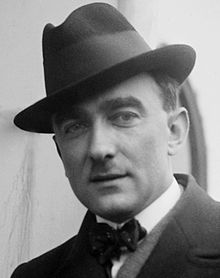Sonata form is a musical structure generally consisting of three main sections: an exposition, a development, and a recapitulation. It has been used widely since the middle of the 18th century.
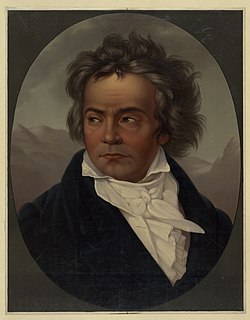
Ludwig van Beethoven's Piano Sonata No. 29 in B♭ major, Op. 106 is a piano sonata that is widely viewed as one of the most important works of the composer's third period and among the greatest piano sonatas of all time. Completed in 1818, it is often considered to be Beethoven's most technically challenging piano composition and one of the most demanding solo works in the classical piano repertoire. The first documented public performance was in 1836 by Franz Liszt in the Salle Erard in Paris.
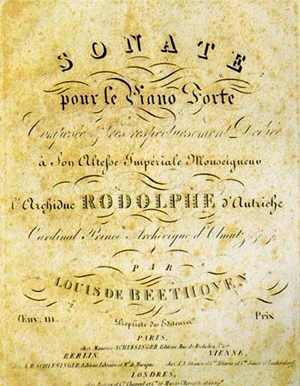
The Piano Sonata No. 32 in C minor, Op. 111, is the last of Ludwig van Beethoven's piano sonatas. The work was written between 1821 and 1822. Like other late period sonatas, it contains fugal elements. It was dedicated to his friend, pupil, and patron, Archduke Rudolf.
Ludwig van Beethoven's Piano Sonata No. 3 in C major, Op. 2, No. 3, is a sonata written for solo piano, composed in 1795. It is dedicated to Joseph Haydn and is often referred to as one of Beethoven's earliest "grand and virtuosic" piano sonatas. All three of Beethoven's Op. 2 piano sonatas contain four movements, an unusual length at the time, which seems to show that Beethoven was aspiring towards composing a symphony. It is both the weightiest and longest of the three Op. 2 sonatas, and it presents many difficulties for the performer, including difficult trills, awkward hand movements, and forearm rotation. It is also one of Beethoven's longest piano sonatas in his early period. With an average performance lasting just about 24–26 minutes, it is second only to the Grand Sonata in E♭ Major, Op. 7, published just a year later, in 1796.

Nikolai Karlovich Medtner was a Russian composer and virtuoso pianist. After a period of comparative obscurity in the 25 years immediately after his death, he is now becoming recognized as one of the most significant Russian composers for the piano.
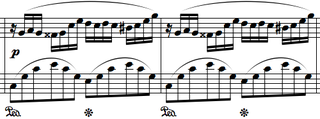
Frédéric Chopin's Fantaisie-Impromptu in C♯ minor, Op. posth. 66, WN 46 is a solo piano composition. It was composed in 1834 and published posthumously in 1855 despite Chopin's instruction that none of his unpublished manuscripts be published. The Fantaisie-Impromptu is one of Chopin's most frequently performed and popular compositions.

The Cello Sonata No. 1 in E minor, Op. 38, entitled "Sonate für Klavier und Violoncello", was written by Johannes Brahms in 1862–65.

The Piano Sonata No. 2 in B♭ minor, Op. 35, is a piano sonata in four movements by Polish composer Frédéric Chopin. Chopin completed the work while living in George Sand's manor in Nohant, some 250 km (160 mi) south of Paris, a year before it was published in 1840. The first of the composer's three mature sonatas, the work is considered to be one of the greatest piano sonatas of the literature.
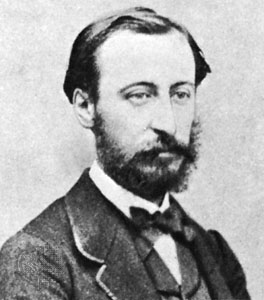
The Piano Concerto No. 4 in C minor, Op. 44 was composed by Camille Saint-Saëns in 1875. It was premièred on October 31, 1875, at the Théâtre du Châtelet of Paris, with the composer as the soloist. The concerto is dedicated to Anton Door, a professor of piano at the Vienna Conservatory. It continues to be one of Saint-Saëns' most popular piano concertos, second only to the Piano Concerto No. 2 in G minor.
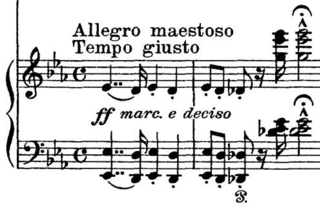
Franz Liszt composed his Piano Concerto No. 1 in E♭ major, S.124 over a 26-year period; the main themes date from 1830, while the final version is dated 1849. The concerto consists of four movements and lasts approximately 20 minutes. It premiered in Weimar on February 17, 1855, with Liszt at the piano and Hector Berlioz conducting.

The Piano Sonata No. 9 in E major, Op. 14, No. 1, is an early-period work by Ludwig van Beethoven, dedicated to Baroness Josefa von Braun, one of his patrons at that time. It was composed in 1798 and arranged for string quartet by the composer in 1801, the result containing more quartet-like passagework and in the more comfortable key of F major.

Piano Sonata No. 13 in E-flat major, Op. 27 No. 1, "Quasi una fantasia", is a sonata composed by Ludwig van Beethoven in 1800–1801.

Ludwig van Beethoven's Piano Sonata No. 22 in F major, Op. 54, was written in 1804. It is contemporary to the first sketches of the Symphony No. 5 in C Minor. It is one of Beethoven's lesser known sonatas, overshadowed by its widely known neighbours, the Waldstein and the Appassionata.
The Piano Sonata in A minor D. 845 (Op.42) by Franz Schubert is a sonata for solo piano. Composed in May 1825 and entitled Premiere Grande Sonata, it is the first of three sonatas published during the composer's lifetime, the others being D.850 and D.894. Conceived as a set, these works were composed during what was reportedly a period of relatively good health and spirits for Schubert, and are praised for their quality and ambition. This first sonata in particular marks a significant step toward the composer’s mature piano sonata style; the format and several characteristic stylistic elements continue through the last.

Piano Sonata No. 1 in D minor, Op. 28, is a piano sonata by Sergei Rachmaninoff, completed in 1908. It is the first of three "Dresden pieces", along with the Symphony No. 2 and part of an opera, which were composed in the quiet city of Dresden, Germany. It was originally inspired by Goethe's tragic play Faust; although Rachmaninoff abandoned the idea soon after beginning composition, traces of this influence can still be found. After numerous revisions and substantial cuts made at the advice of his colleagues, he completed it on April 11, 1908. Konstantin Igumnov gave the premiere in Moscow on October 17, 1908. It received a lukewarm response there, and remains one of the least performed of Rachmaninoff's works.

The Love Songs of Hafiz is the name of two song cycles by Karol Szymanowski, Op. 24, with piano accompaniment, and Op. 26, with orchestral accompaniment. There are six songs in Op. 24, three of them orchestrated in Op. 26, and five additional songs, unique to Op. 26. They were composed in Vienna, Austria, in 1911 and 1914, respectively. The works represent a transition between the first and second periods of the composer's style.
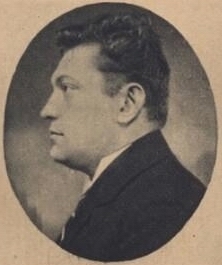
Jaroslav Kvapil was a Czech composer, teacher, conductor and pianist.
Karol Szymanowski completed his Symphony No. 2 in B flat major, Op. 19 in 1909 at the age of 27. Szymanowski was greatly influenced by German culture and the symphony has many echoes of Richard Strauss and Max Reger. This symphony introduced Szymanowski to Europe in 1911-12, following its Warsaw premiere on 7 April 1911 and it was heard in Berlin, Leipzig and Vienna. The symphony was published soon after the composer's death after much revision. This symphony and its use of a solo violin laid the foundation, so to speak, of Szymanowski's first Violin Concerto. A typical performance of the symphony lasts about 30 minutes.
Polish composer Karol Szymanowski worked on his Symphony No. 1 in F minor Op. 15 between 1906 and 1907.
The Symphony No. 4 Op. 60 is a work for solo piano and orchestra written by the Polish composer Karol Szymanowski between March and June of 1932. It is dedicated to the pianist Arthur Rubinstein. Szymanowski himself played the piano part at the premiere performance on 9 October 1932, with Grzegorz Fitelberg conducting the Poznań City Orchestra.
